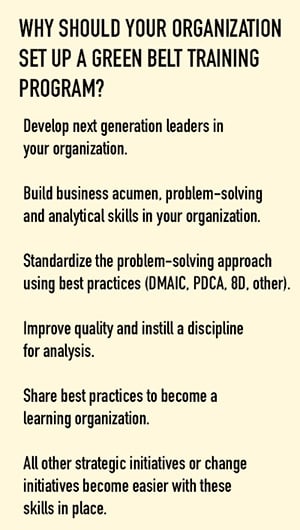How do You Launch a Green Belt Training Program?
This blog will present 14 ideas for starting your Green Belt program, but first… What is a Green Belt program?
What is a Green Belt Training Program?
Green belt training teaches candidates the basic tools used by a project team and how to apply the skills that relate to a continuous improvement project. These specially-trained people are typically trained to solve problems, or reduce waste in processes using a Lean or Six Sigma methodology. A good green belt training program should train project leaders in the disciplines of project management, quality, elimination of waste, and aligning project goals with business objectives.
Green belts are employees of an organization who have been trained on continuous improvement methodology and will lead a process improvement team as part of their full‐time job. Green belts have a thorough understanding of the everyday practices needed to sustain a continuous improvement culture and manage processes in all areas of an organization.
A green belt provides value within your organization in a variety of ways. They serve on project teams to support and accelerate progress in continuous improvement projects—which help to maximize your organization’s return on its investment, and add capacity to deliver even greater numbers of breakthrough improvement projects throughout the company.
Continuously Improve With Our Latest News & Updates
How do You Launch a Green Belt Training Program?
1. Start by Selling the Big Picture. Continuous Improvement is the most important strategic pillar that an organization can pursue. Regardless of the industry you are in, you need to get better or your competitors will surpass you eventually. A successful green belt program is the engine for a Continuous Improvement Culture. If you are the CEO, then this is easy (or, easier) as you can make a green belt program part of your strategic plan. If you are somewhere else in the organization, you will need to “sell up” the ladder to the appropriate levels. If you can find an existing strategic pillar such as “Operational Excellence” or “Continuous Improvement” then you will have an angle to make this work.
2. Establish Continuous Improvement as a Strategic Pillar. If your organization isn’t bought off on this idea, then you should start here.
- Why: Continuous Improvement is the key to winning in a hyper-competitive environment. It should be part of every company’s strategy.
- How: Present the idea to the CEO and other leaders. Discuss how others in your industry are using continuous improvement as a strategic pillar.
- Headcount: You have to invest in continuous improvement. A minimum of one person will be required to organize a program that focuses on continuous improvement efforts, training staff to Lean problem solving techniques, and coaching teams through their projects. This can be an internal resource or you can hire an experienced Lean coach from the outside. Often an external coach can accomplish more as they are seen as a subject matter expert and can work outside of political challenges faced by internal leaders.
3. Make a list of potential projects or ideas for projects. These projects are the work of the green belt program. Review your existing strategic projects. Most companies will have some form of a strategic plan with various strategic projects. Some of these strategies or goals, or initiatives will be great projects. Establish some goals in the form of projects you can accomplish. Do you want to get ISO certified? ISO certification requires a continuous improvement program.
belt program. Review your existing strategic projects. Most companies will have some form of a strategic plan with various strategic projects. Some of these strategies or goals, or initiatives will be great projects. Establish some goals in the form of projects you can accomplish. Do you want to get ISO certified? ISO certification requires a continuous improvement program.
4. Make a list of potential candidates.These are people who want to make an impact on the business and advance their careers. A well-run green belt program can fit well with any sort of career path development initiatives that your HR department might be coming up with. The people you invite to your green belt program will be the future leaders of the organization. Green belt programs teach a problem-solving discipline Identify the right people (leaders who want to make things better)
5. Check in with other departments. If you are building a green belt program without interacting with other departments in the organization you are missing out on a great opportunity to get some champions for your cause. Meet with the HR department, find out how they are planning to promote career path development. Can your green belt program fit in? Go talk to the leaders, find out what are the important KPIs that need to move. Pick an area of the company to focus on and make an impact there.
6. Find an expert who had done it before. Most companies who are starting a green belt program have at least one person inside who has done it before, or you can choose to work with a consultant to get things started. Contact us for recommendations.
7. Attend a conference or workshop. If you want to get more familiar with green belt programs or continuous improvement culture, there are a wide variety of conferences you can go to.
8. Decide on a methodology. Will you use DMAIC or PDCA? Both can work, but you should settle on one that you will use. This video explains more.
 9. Give it a name. You can use the green belt program terminology, or you can make up a name that suits you, you might think of this as a PMO (Project Management Office). The key is that you establish this effort as a program that has some dedicated resources, defined goals, and executive visibility.
9. Give it a name. You can use the green belt program terminology, or you can make up a name that suits you, you might think of this as a PMO (Project Management Office). The key is that you establish this effort as a program that has some dedicated resources, defined goals, and executive visibility.
10. Pitch it to executives like a project. Just like you would build a business case for an improvement project, building a green belt training program is a project initiative that should have a good charter, a measurable desired outcome, and a scope of work.
11. Slow down to go faster. Early projects should focus on things that make people’s lives easier and better. This point is counter-intuitive in some ways. You might be thinking that the first thing you want to show is immediate ROI and cost savings on projects. Based on experience, this can backfire. It is better to take a slower approach with initial green belt projects and start by improving the problems that average workers and managers face. If they see your new program as something that actually helps them and makes their jobs easier and better, they are much more likely to support you and grow the program.
12. Establish metrics on which you will judge your success. The number of people involved, the number of ideas generated, the number of projects initiated, the number of projects completed, the dollar amount of project benefit received.
13. Establish a management cadence. If you are training green belts, don’t just do it one time and then forget it. Plan on doing a new training each quarter, or each year.
14. Make it fun. Report on your successes. It is a best practice to celebrate the successes of the program and share your successes with the organization. This can be done in the form of a monthly or quarterly email or newsletter, Slack messages, team board, or any other way of celebrating the successes of the team.
Have you started a Green Belt training program at your organization? We would love to hear from you! Are you working as a consultant who can help companies do this? We would love to hear from you! Contact us.







